
In Q2-2019, some publicly listed online gaming companies took the last bus and announced their 2018 annual financial reports. How were those online game manufacturers doing in in 2018? Let's have a look those financial reports from 64 top listed gaming companies and found out the answer.
For all game makers, they experienced a tough period of
pain in 2018, and the figures in the financial reports accurately reflect the
extent of the pain. Overall, 28 of the 64 listed companies reported a
year-on-year decline in revenue, while 11 reported a year-on-year increase of
less than 10% in revenue. In terms of net profit, there are as many as 18 listed
companies that suffered loss.
If ranked by revenue, the rankings are as follows. It
should be pointed out that, in addition to Tencent, NetEase and a few other
companies that have announced the specific revenue of the game business, the
rest of the company's performance is based on the group's revenue and profits
(represented by *). Tencent and NetEase's net profit also refers to the group's
net profit.
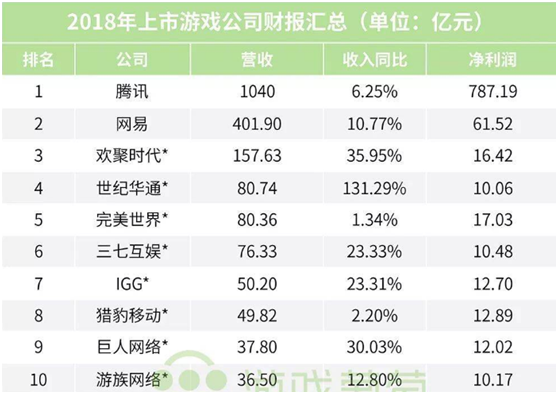
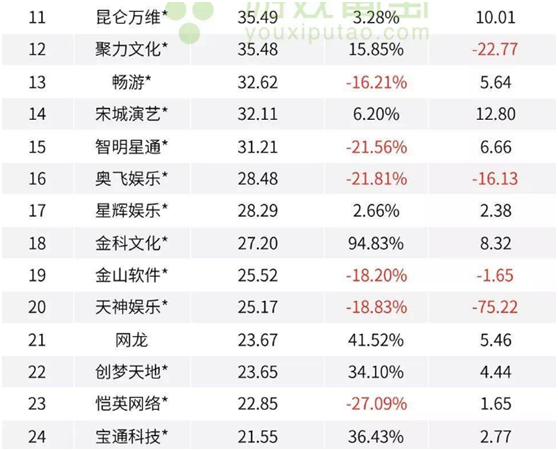
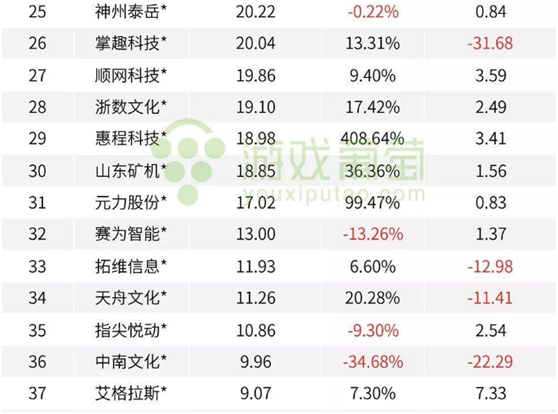
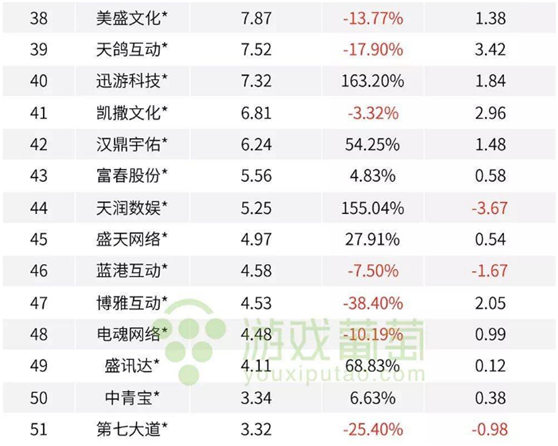
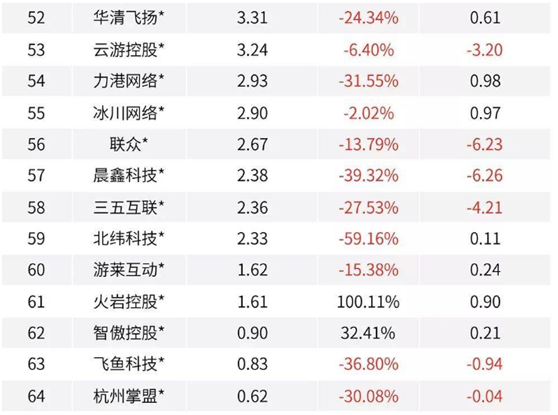
35 companies’ revenues were over $1 billion, but 9 of them shrunk compare to last year.
In terms of revenue, we can divide the listed game companies into three echelons. The first echelon is attributed to Tencent and NetEase. The former's online game revenue in 2018 was 104 billion RMB, an increase of 6.25% over the same period of last year, while the latter's net online game revenue was 40.190 billion RMB, an increase of 10.77% over the same period of last year.
Apart from Tencent NetEase, other companies with revenue of more than 1 billion settled in the second echelon. It includes not only the old manufacturers such as Sanqihuyu, Perfect World and the newly renamed Shengqu Game, but also the new members like Chuangmengtiandi, which have just been listed. Of the 33 companies in the echelon, 24 achieved revenue growth year-on-year, the largest increase was Huicheng Technology (408.64%), and Huicheng Technology gave part of the credit to Duokemeng, which was acquired at the end of 2017. In addition, the revenue of Shijihuatong, Sanqihuyu, IGG, Giant Networks, Wanglong and some other companies all exceeded 20% year on year.
Changes in the market environment have also slowed down the revenue growth of a number of companies. Seven of the second echelon's revenue increased by less than 10% year-on-year, and nine even fell by more than 20% year on year.
The third echelon consists of 29 companies with revenues below 1 billion. This echelon is facing a more serious situation in 2018, with only 10 companies showing year-on-year revenue growth and the rest falling. This may not be difficult to understand. Firstly, the Matthew effect of the market is increasing, squeezing the space of some small and medium-sized teams. Secondly, the new products are late to the line, companies rely too much on old products to drive revenue, but the old products are naturally degraded, the revenue capacity thus declined sharply. Thirdly, capital enthusiasm has subsided, and the phenomenon of mergers and acquisitions has decreased, which has made some companies' transcripts less attractive.
Nearly half of net profit is less than 100 million, and the biggest loss is as high as 7.5 billion.
After that, let's look at the net profit. In the 2017 financial report summary, I mentioned that at that time 38 of the 50 companies had net profits of more than 100 million RMB and 9 companies doubled their net profits. So what about this year?
According to net profit, listed companies ranking as
follows:
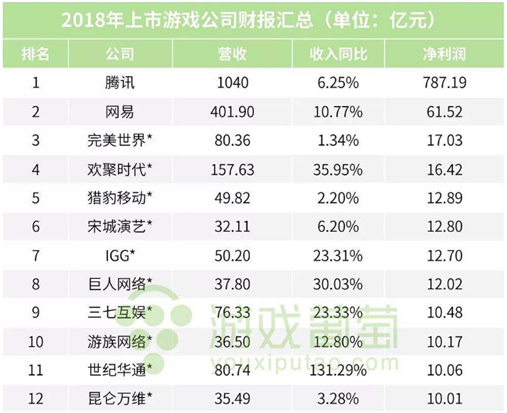
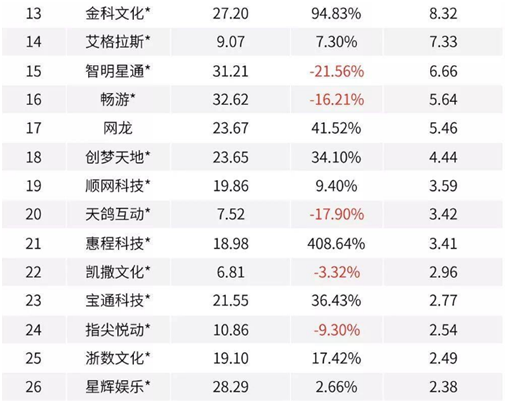
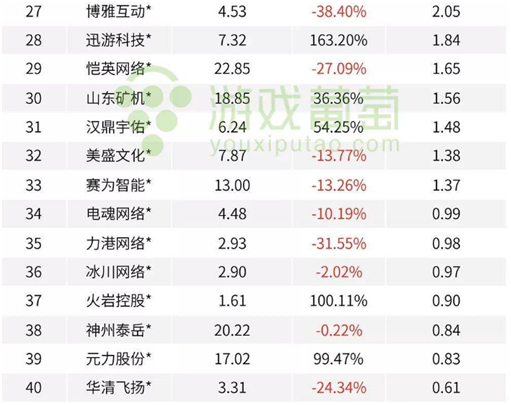
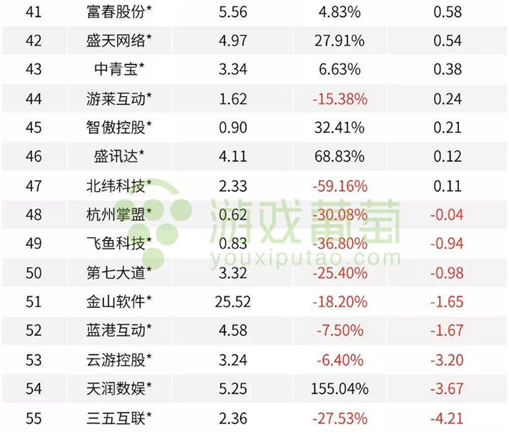
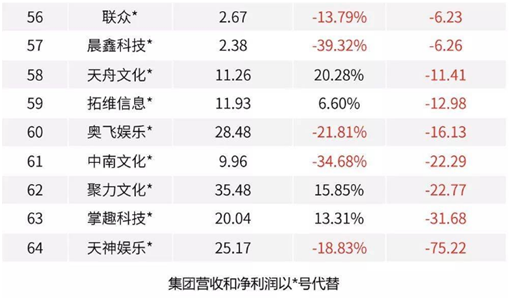
After sorting out, we found that there are 12 companies with net profit exceeding 1 billion RMB, which are still led by Tencent and NetEase, and other well-known manufacturers such as Perfect World, Cheetah Mobile, IGG, Giant Network. However, it should be pointed out that the net profit of five manufacturers in this camp suffered a year-on-year decline.
There are 21 companies with a net profit of 0.1-1 billion RMB, which means that 33 companies have net profits of more than $100 million RMB, slightly lower than the same period of last year. In addition, seven companies experienced a year-on-year decline, and these companies with certain capital are starting to have a tough time.
The results after that were even worse. As many as 31 listed companies have net profit of less than 100 million, and 17 are even losing money. In the list, Tianzhou Culture, Tuowei Information, Aofei Entertainment, Zhongnan Culture, Juli Culture, OURPALM, and Zeus Entertainment have a loss of more than 1 billion, and the biggest loss appears in Zeus Entertainment, which is 7.5 billion.
From a net profit of 1.015 billion in 2017 to a loss of 7.5 billion in 2018, Zeus Entertainment's report card was a big surprise. In fact, the decline in Zeus Entertainment's performance is reflected in the performance forecast at the end of January this year. In the announcement, Zeus Entertainment filled in an estimated of 4.814 billion RMB in the impairment of goodwill, which is also a major reason for the sharp decline in its performance. The devaluation of goodwill in the past year has occurred not only in Zeus Entertainment but also in many other game companies.
The following factors are indispensable to the cliff-like decline
performance
Perhaps many people still remember the word "goodwill impairment" mentioned by the listed companies that suffered loss at the end of January.
For example, when a listed company invests 1 million RMB to acquire a game company with a identifiable net asset value of 100,000, and the remaining 900,000 RMB is called as goodwill. If the game company cannot create a 900,000 RMB value, then the goodwill will be impaired.
The Securities Daily reported that as of January 30, 130 of the two cities had forecasted losses, 110 of which were associated with the impairment of goodwill, which was nearly three times higher than the same period last year. In the above list, 15 companies mentioned the impact of impairment of goodwill on financial reports. The estimated amount of impairment of goodwill is from millions to billions. There are also a small number of companies that have not publicly disclosed the specific impairment amounts.
As shown in the following figure, all 15 companies are A-share listed companies, and they have had a large number of mergers and acquisitions:
For example, Ju Li Culture acquired 100% share of Suzhou Meishengyuan in 2016, forming a goodwill of over 3 billion RMB. Since 2011, Zhongnan Culture has formed a total goodwill of approximately 2.287 billion RMB due to the merger of enterprises under different control (including the acquisition of shares in Aurora Network); Tuowei Information acquired 90% equity of Shanghai HRG Information in 2014, forming a goodwill of 827 million RMB and so on.
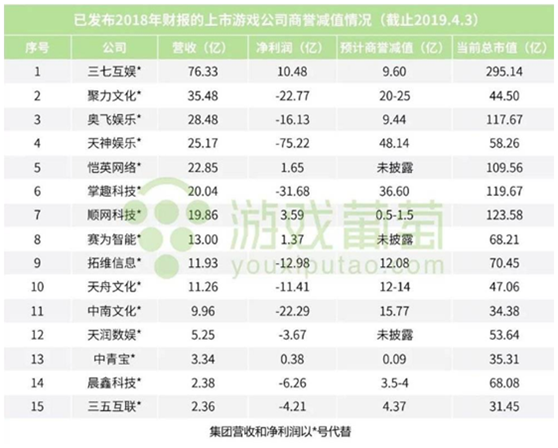
After that, these mergers and acquisitions, either because of changes in industry policies or because of changes in internal business adjustments, making it difficult for holding companies to deliver the expected results, thus putting listed companies at risk of impairment of goodwill. For example, Zeus Entertainment, which has purchased RayJoy, Miaoquhengsheng and Oasis Games, mentioned in the announcement that the game industry involved in the context of the disappearance of demographic dividends, the decline of industry growth, fierce market competition and the pressure of regulatory policies, then the company decided to assess and prepare for the signs of impairment.
In fact, goodwill impairment accounts for only a quarter of this list. For other companies suffering from performance decline, they did not participate in large-scale mergers and acquisitions, but the cold winter of the industry also lead to more and more pressure for enterprises’ survival.
On the one hand, the old games of the company are gradually developing from maturity to recession. Users are naturally attenuated and divided by new games on the market. At the same time, the new users' access threshold is raised. It is difficult to ensure a good cyclic ecology in the game.
On the other hand, the new product has not been able to get its version number in the past year, and cannot be put online and converted into real income. At the same time, listed companies also faced the cost pressure of R&D team, layoffs, downsizing, and these cases have occurred in most companies.
After the version number is opened, will the financial report in 2019 be improved?
To be sure, the financial reports of listed companies in 2018 are the worst reports in recent years. Let us looking forward the reports of 2019 in a year's time. Will the downward trend be reversed?
Regardless of other uncertainties, the reboot of version number at the beginning of the year can be seen as a key point for game companies to reverse their performance. In the past three months, the Edition Department has issued 11 batches of version numbers, nearly 1000 approved games, and it also has just announced the first batch of imported game versions, and 30 games have been successfully approved.
With the opening of the version number, more and more new games will be on the right track to create profits for the companies. And the game companies will also cherish the hard-won version number and concentrate on improving the games. Perhaps a year later, these listed companies would have the opportunity to show their strength by delivering their best results.



